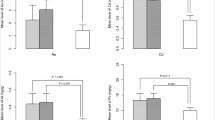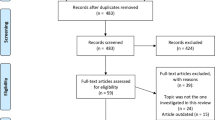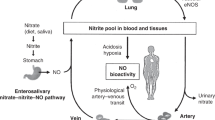Abstract
Objective:
To evaluate the influence of maternal smoking on antioxidative capacity and intensity of oxidative damage in breast milk.
Study Design:
The study group (n=30) was comprised of postpartum women who declared smoking more than five cigarettes per day during pregnancy and lactation (confirmed by the urinalysis of cotinine concentration), and their newborns. Control group included 29 non-smoking postpartum women and their newborns. Colostrum samples were collected on the 3rd day after delivery and breast milk samples between the 30th and the 32nd day after delivery. Morning maternal and neonatal urine samples were obtained on the day of the mature milk sampling. Isoprostane concentrations in colostrum/mature milk and urine were determined immunoenzymatically. Total Antioxidant Status (TAS) of colostrum/breast milk was determined by Rice–Evans and Miller method.
Result:
Colostrum TAS in smokers was significantly lower than in non-smokers (P=0.006). In both groups, the TAS of mature milk was higher compared with colostrum, but significant differences were observed amongst smokers only (P=0.001). In smokers the isoprostane concentration of mature milk was significantly higher than the colostrum concentration (P=0.001). Significant inverse correlation between maternal urinary isoprostane concentration and the TAS of mature breast milk was observed in smokers (R=−0.525, P=0.023), but not in non-smokers (R=0.161, P=0.422).
Conclusion:
This study revealed that maternal smoking triggers harmful effects on an infant by impairing pro-oxidant–antioxidant balance of breast milk.
This is a preview of subscription content, access via your institution
Access options
Subscribe to this journal
Receive 12 print issues and online access
$259.00 per year
only $21.58 per issue
Buy this article
- Purchase on Springer Link
- Instant access to full article PDF
Prices may be subject to local taxes which are calculated during checkout
Similar content being viewed by others
References
Thibeault DW . The precarious antioxidant defenses of the preterm infant. Am J Perinatol 2000; 17: 167–181.
Quiles JL, Ochoa JJ, Ramirez-Tortosa MC, Linde J, Bompadre S, Battino M et al. Coenzyme Q concentration and total antioxidant capacity of human milk at different stages of lactation in mothers of preterm and full-term infants. Free Radic Res 2006; 40: 199–206.
Shoji H, Oguchi S, Shinohara K, Shimizu T, Yamashiro Y . Effects of iron-unsaturated human lactoferrin on hydrogen peroxide-induced oxidative damage in intestinal epithelial cells. Pediatr Res 2007; 61: 89–92.
Shoji H, Oguchi S, Fujinga S, Shinohara K, Kaneko K, Shimizu T et al. Effects of human milk and spermine on hydrogen peroxide-induced oxidative damage in IEC-6 cells. J Pediatr Gastroenterol Nutr 2005; 41: 460–465.
Shoji H, Shimizu T, Shinohara K, Oguchi S, Shiga S, Yamashiro Y . Suppressive effects of breast milk on oxidative DNA damage in very low birthweight infants. Arch Dis Child Fetal Neonatal Ed 2004; 89: F136–F138.
L′Abbe MR, Friel JK . Superoxide dismutase and glutathione peroxidase content of human milk from mothers of premature and full-term infants during the first 3 months of lactation. J Pediatr Gastroenterol Nutr 2000; 31: 270–274.
Ermis B, Yildirim A, Örs R, Tastekin A, Ozkan B, Akcay F . Influence of smoking on serum and milk malondialdehyde, superoxide dismutase, glutathione peroxidase, and antioxidant potential levels in mothers at the postpartum seventh day. Biol Trace Elem Res 2005; 105: 27–36.
Aycicek A, Erel O, Kocyigit O, Selek S, Demirkol MR . Breast milk provides better antioxidant power than does formula. Nutrition 2006; 22: 616–619.
Friel JK, Martin SM, Langdon M, Herzberg GR, Buettner GR . Milk from mothers of both premature and full-term infants provides better antioxidant protection than does infant formula. Pediatr Res 2002; 51: 612–618.
Faure H, Preziosi P, Roussel AM, Bertrais S, Galan P, Hercberg S et al. Factors influencing blood concentration of retinol, alpha-tocopherol, vitamin C, and beta-carotene in the French participants of the SU.VI.MAX trial. Eur J Clin Nutr 2006; 60: 706–717.
Reilly M, Delanty N, Lawson JA, Fitzgerald GA . Modulation of oxidant stress in vivo in chronic cigarette smokers. Circulation 1996; 94: 19–25.
Montuschi P, Barnes P, Roberts LJ . Insights into oxidative stress: the isoprostanes. Curr Med Chem 2007; 14: 703–717.
Roberts LJ, Morrow JD . Measurement of F(2)-isoprstanes as an index of oxidative stress in vivo. Free Rad Biol Med 2000; 28: 505–513.
Rice-Evans C, Miller NJ . Total antioxidant status in plasma and body fluids. Methods Enzymol 1994; 234: 279–293.
Jaffé MZ . About the precipitation caused by pikrinic acid in normal urine and about a new reaction of creatinine. Physiol Chem 1886; 10: 391–400.
Riboli E, Haley NJ, Tredaniel J, Saracci R, Preston MS, Trichopoulos D . Misclassification of smoking status among women in relation to exposure to environmental tobacco smoke. Eur Respir J 1995; 8: 285–290.
Szlagatys-Sidorkiewicz A, Zagierski M, Renke J, Korzon M . Total antioxidative status in colostrum. The influence of maternal smoking. Med Wieku Rozwoj 2005; 9: 621–628.
Ortega RM, López-Sobaler AM, Martinez RM, Andrés P, Quintas ME . Influence of smoking on vitamin E status during the third trimester of pregnancy and on breast-milk tocopherol concentrations in Spanish women. Am J Clin Nutr 1998; 68: 662–667.
Ortega RM, López-Sobaler AM, Quintas ME, Martinez RM, Andrés P . The influence of smoking on vitamin C status during the third trimester of pregnancy and on vitamin C levels in maternal milk. J Am Coll Nutr 1998; 17: 379–384.
Chechlowska M, Ambroszkiewicz J, Gajewska J, Laskowska-Klita T, Leibschang J . The effect of tobacco smoking during pregnancy on plasma oxidant and antioxidant status in mothers and newborn. Eur J Obstet Gynecol Reprod Biol 2011; 155: 132–136.
Argüelles S, Machado MJ, Ayala A, Machado A, Hervias B . Correlation between circulating biomarkers of oxidative stress of maternal and umbilical cord blood at birth. Free Radic Res 2006; 40: 565–570.
Aycicek A, Erel O, Kocyigit A . Decreased total antioxidant capacity and increased oxidative stress in passive smoker infants and their mothers. Pediatr Int 2005; 47: 635–639.
Bolisetty S, Naidoo D, Lui K, Koh TH, Watson D, Montgomery R et al. Postnatal changes in maternal and neonatal plasma antioxidant vitamins and the influence of smoking. Arch Dis Child Fetal Neonatal Ed 2002; 86: F36–F40.
de Barros Silva SS, Rondó PH, Erzinger GS . Beta-carotene concentrations in maternal and cord blood of smokers and non-smokers. Early Hum Dev 2005; 81: 313–317.
Moji H, Murata T, Morinobu T, Manago M, Tamai H, Okamoto R et al. Plasma levels of retinol, retinol-binding protein, all-trans beta-carotene and cryptoxanthin in low birth weight infants. J Nutr Sci Vitaminol (Tokyo) 1995; 41: 595–606.
Friel JK, Friesen RW, Harding SV, Roberts LJ . Evidence of oxidative stress in full-term healthy infants. Pediatr Res 2004; 56: 878–882.
Friel JK, Diehl-Jones B, Cockell KA, Chiu A, Rabanni R, Davies SS et al. Evidence of oxidative stress in relation to feeding type during early life in premature infants. Pediatr Res 2011; 69: 160–164.
Kukla L, Hrubá D, Tyrlík M . Influence of prenatal and postnatal exposure to passive smoking on infants′ health during the first six months of their life. Centr Eur J Public Health 2004; 12: 157–160.
Author information
Authors and Affiliations
Corresponding author
Ethics declarations
Competing interests
The authors declare no conflict of interest.
Additional information
Author contribution
Each of the six co-authors has made substantive intellectual contribution to the study (conception and design, acquisition of data or analysis and interpretation of data, drafting of the manuscript or revising it critically for important intellectual content) and takes public responsibility for appropriate portions of the content of the manuscript.
Rights and permissions
About this article
Cite this article
Zagierski, M., Szlagatys-Sidorkiewicz, A., Jankowska, A. et al. Maternal smoking decreases antioxidative status of human breast milk. J Perinatol 32, 593–597 (2012). https://doi.org/10.1038/jp.2011.156
Received:
Accepted:
Published:
Issue Date:
DOI: https://doi.org/10.1038/jp.2011.156
Keywords
This article is cited by
-
Maternal smoking around birth may lower the protective effects of breastfeeding on anxiety, depression and neuroticism in adult offspring: a UK biobank study
European Archives of Psychiatry and Clinical Neuroscience (2023)
-
The effect of tobacco smoking during pregnancy and breastfeeding on human milk composition—a systematic review
European Journal of Clinical Nutrition (2021)



